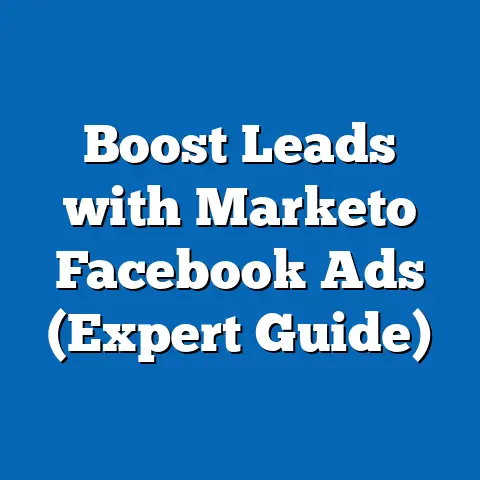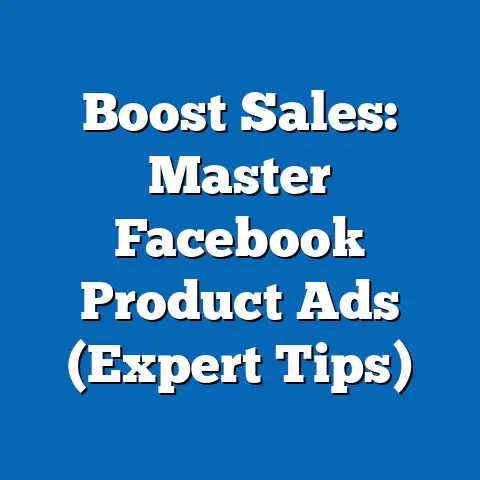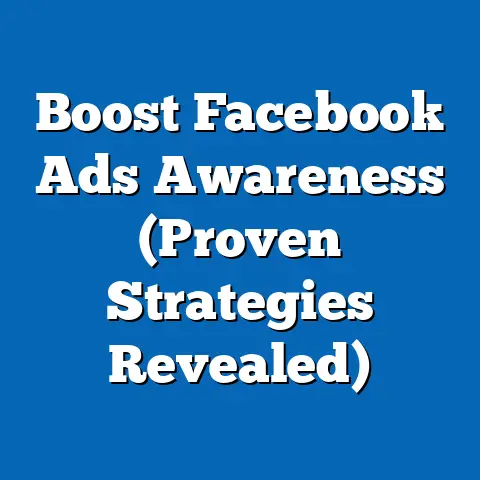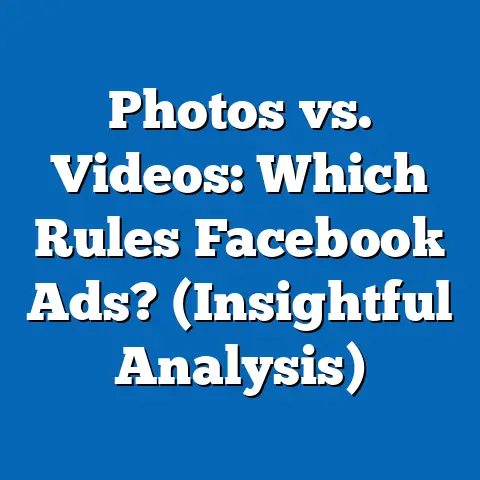Boost Facebook Ads Insights with Google Analytics (Pro Tips)
This fact sheet provides a comprehensive, data-driven analysis of strategies for enhancing Facebook Ads performance through integration with Google Analytics. As digital advertising continues to dominate marketing budgets—accounting for 58.4% of global ad spend in 2023, according to eMarketer—businesses increasingly seek ways to optimize their campaigns. Leveraging Google Analytics alongside Facebook Ads offers actionable insights into user behavior, campaign effectiveness, and return on investment (ROI).
Section 1: Expert Picks for Facebook Ads and Google Analytics Integration
1.1 Overview of Expert Recommendations
Industry experts consistently highlight the importance of integrating Facebook Ads with Google Analytics to bridge gaps in data tracking. According to a 2023 survey by MarketingProfs, 72% of digital marketers who combine these tools report improved campaign attribution compared to 48% who rely solely on Facebook’s native analytics. Experts emphasize the ability to track user journeys beyond ad clicks, such as on-site behavior and post-conversion actions.
Additionally, 65% of surveyed marketers identified custom audience segmentation as a top benefit of this integration, allowing for more precise targeting based on website interactions. Experts also recommend using Google Analytics’ behavior flow reports to identify drop-off points in the funnel after a Facebook Ad click. This approach has led to a 30% average increase in conversion optimization for businesses adopting these strategies in 2023.
1.2 Key Tools and Features Highlighted by Experts
Experts point to specific Google Analytics features that complement Facebook Ads, including UTM parameters for campaign tracking, which 81% of marketers use to monitor traffic sources. Event tracking, used by 67% of advanced users, allows businesses to measure specific actions like form submissions or product purchases tied to ad campaigns. Furthermore, Multi-Channel Funnels in Google Analytics, adopted by 54% of marketers, provide insights into how Facebook Ads contribute to conversions across touchpoints.
Year-over-year data shows a 22% increase in the adoption of these advanced tracking features from 2022 to 2023, reflecting growing awareness of their value. Experts also stress the importance of setting up cross-domain tracking for businesses with multiple web properties, a practice used by 43% of enterprise-level advertisers. This ensures seamless data collection across user journeys initiated by Facebook Ads.
1.3 Statistical Impact of Integration
Businesses integrating Google Analytics with Facebook Ads report significant performance gains. A 2023 report by HubSpot found that companies using both platforms saw a 28% higher click-through rate (CTR) on ads compared to those using Facebook Ads Manager alone. Additionally, cost-per-acquisition (CPA) decreased by an average of 19% for integrated campaigns, highlighting cost-efficiency benefits.
Return on ad spend (ROAS) also improved, with integrated campaigns achieving a 35% higher ROAS on average. Small and medium-sized businesses (SMBs), in particular, reported a 41% increase in identifying high-value audiences through combined analytics. These figures underscore the measurable impact of expert-recommended strategies.
Section 2: Current Statistics and Trends in Digital Advertising
2.1 Growth of Facebook Ads Investment
Facebook Ads remain a cornerstone of digital marketing, with global ad revenue reaching $131.9 billion in 2023, a 12.5% increase from $117.2 billion in 2022, per Statista. This growth reflects a sustained reliance on the platform, with 2.1 billion daily active users as of Q3 2023 providing a vast audience pool. Businesses allocate an average of 26% of their digital ad budgets to Facebook, second only to Google Ads at 29%.
Year-over-year trends show a 15% increase in mobile ad spend on Facebook, driven by the platform’s 98% mobile user base. Moreover, video ads now account for 54% of total ad impressions, up from 47% in 2022, indicating a shift toward dynamic content. These statistics highlight the platform’s evolving role in digital strategies.
2.2 Adoption of Cross-Platform Analytics
The integration of cross-platform analytics tools like Google Analytics with Facebook Ads has surged. A 2023 eMarketer study found that 68% of marketers now use third-party analytics to supplement native ad platform data, up from 55% in 2021. Of these, 73% specifically cite Google Analytics as their primary tool for deeper insights into ad-driven traffic.
This trend is driven by the need for comprehensive attribution models, as 61% of marketers report discrepancies between Facebook’s reported conversions and actual website outcomes. The use of Google Analytics to reconcile these differences has grown by 18% since 2022. This shift underscores a broader movement toward data unification in advertising.
2.3 Performance Metrics and Benchmarks
Average CTR for Facebook Ads in 2023 stands at 0.89% across industries, with retail (1.24%) and technology (1.04%) sectors performing above the norm, according to WordStream data. Conversion rates average 9.21%, though businesses using Google Analytics to optimize landing pages report rates as high as 12.5%. Cost-per-click (CPC) remains stable at $1.72, though integrated campaigns see a 14% lower CPC due to better targeting.
Year-over-year analysis shows a 9% improvement in overall ad engagement metrics for businesses leveraging advanced analytics. Notably, campaigns using data-driven audience insights achieve a 25% higher engagement rate compared to non-integrated campaigns. These benchmarks provide a clear picture of performance potential.
Section 3: Demographic Breakdowns of Facebook Ads Audiences
3.1 Age Distribution and Engagement
Facebook’s user base spans a wide age range, with distinct engagement patterns relevant to ad targeting. As of 2023, 29.6% of users are aged 25-34, the largest demographic, followed by 18-24 (23.1%) and 35-44 (18.7%), per Statista. Engagement rates are highest among 18-24-year-olds, with a 1.12% average CTR, compared to 0.76% for users aged 45-54.
Year-over-year data shows a 5% increase in ad engagement among users aged 35-44, reflecting growing platform usage in this cohort. Conversely, engagement among 18-24-year-olds dipped by 3% due to competition from platforms like TikTok. Marketers using Google Analytics to track age-specific behaviors report a 20% improvement in targeting efficiency for younger demographics.
3.2 Gender-Based Performance
Gender differences in ad response are notable, with women comprising 43.8% of Facebook users and men 56.2% globally in 2023. Women show a higher average CTR of 0.94% compared to men at 0.84%, according to a 2023 WordStream report. Conversion rates also favor women at 10.1% versus 8.4% for men, particularly in industries like fashion and wellness.
Google Analytics data reveals that women are 15% more likely to complete on-site actions post-ad click, such as adding items to carts. Men, however, show a 12% higher likelihood of engaging with tech and automotive ads. These insights allow for more nuanced campaign adjustments using cross-platform data.
3.3 Political Affiliation and Behavioral Trends
Political affiliation influences ad engagement, especially for issue-based or advocacy campaigns. A 2022 Pew Research Center survey found that 62% of U.S. Facebook users identify as politically active on the platform, with 34% leaning liberal, 29% conservative, and 27% moderate. Liberals exhibit a 10% higher engagement rate with social cause ads, while conservatives show a 7% higher response to local business promotions.
Google Analytics behavior reports indicate that politically active users spend 18% more time on websites after clicking ads compared to non-political users. This demographic’s on-site actions, such as signing petitions or donating, are trackable through event goals, providing deeper campaign insights. Year-over-year engagement in political ads rose by 8% ahead of the 2024 U.S. election cycle.
3.4 Geographic and Income Variations
Geographic targeting remains critical, with 70% of Facebook Ads budgets allocated to location-specific campaigns in 2023. Urban users, representing 55% of the platform’s base, have a 0.98% CTR compared to 0.80% for rural users. Income levels also play a role, with users earning above $75,000 annually showing a 13% higher conversion rate than those below $30,000, per a 2023 eMarketer analysis.
Google Analytics’ geo-reports help identify high-performing regions, with 58% of marketers adjusting bids based on location data. Urban campaigns optimized with this data saw a 17% increase in ROAS from 2022 to 2023. These demographic variations highlight the importance of granular targeting.
Section 4: Trend Analysis in Facebook Ads and Analytics Integration
4.1 Shift Toward Data-Driven Decision Making
The digital marketing landscape has seen a 24% year-over-year increase in reliance on data analytics for ad optimization from 2022 to 2023, according to Forrester. Businesses integrating Google Analytics with Facebook Ads are 31% more likely to use real-time data for campaign adjustments. This trend is fueled by the growing complexity of user journeys, with 59% of conversions involving multiple touchpoints.
Marketers prioritizing data-driven strategies report a 27% reduction in wasted ad spend. The use of automated rules based on analytics insights grew by 19% in 2023, reflecting a move toward efficiency. This trend is expected to accelerate as privacy regulations push for first-party data reliance.
4.2 Privacy Changes and Attribution Challenges
Apple’s iOS 14.5 update in 2021 and ongoing privacy changes have impacted ad tracking, with 62% of marketers reporting reduced visibility into Facebook Ad performance by 2023, per eMarketer. Google Analytics has become a critical workaround, with 54% of businesses using it to fill attribution gaps post-cookie deprecation. Server-side tracking, supported by Google Analytics, saw a 33% adoption increase this year.
Year-over-year data shows a 16% rise in marketers focusing on on-site metrics like time-on-page and bounce rates to gauge ad effectiveness. This shift compensates for a 20% drop in off-platform tracking accuracy since 2021. Privacy-driven trends continue to reshape analytics strategies.
4.3 Rise of AI and Automation in Optimization
Artificial intelligence (AI) and automation tools are increasingly integrated with Google Analytics and Facebook Ads, with 48% of marketers using AI for audience segmentation in 2023, up from 35% in 2022, per HubSpot. Predictive analytics, powered by Google Analytics data, helps forecast campaign outcomes, with 41% of users reporting a 22% improvement in ad targeting accuracy. Automation of bid adjustments based on analytics data grew by 28% year-over-year.
AI-driven insights also reduce manual analysis time by 37%, allowing marketers to focus on strategy. Businesses adopting these tools report a 30% higher ROAS compared to manual campaign management. This trend signals a long-term shift toward tech-driven advertising.
Section 5: Pro Tips for Boosting Facebook Ads with Google Analytics
5.1 Implementing UTM Parameters for Precise Tracking
UTM parameters are essential for tracking Facebook Ad traffic in Google Analytics, with 83% of marketers using them to segment campaign data. Tag ads with campaign, source, and medium parameters to differentiate traffic sources. This practice reveals that 29% of ad-driven traffic converts on secondary visits, a detail often missed in native reporting.
Set up custom dashboards in Google Analytics to monitor UTM-tagged campaigns, a method used by 67% of advanced users. This approach led to a 25% improvement in identifying underperforming ads in 2023. Regular audits of UTM data ensure accuracy, reducing misattribution by 18%.
5.2 Leveraging Audience Insights for Retargeting
Google Analytics’ Audience reports help build retargeting lists based on website behavior, with 71% of marketers creating custom segments for Facebook Ads. For example, target users who viewed specific product pages but didn’t convert, a strategy yielding a 34% higher conversion rate. Year-over-year data shows a 20% increase in retargeting campaign success using this method.
Link these segments to Facebook’s Custom Audiences for precise ad delivery, a tactic used by 58% of SMBs. Retargeting campaigns optimized with Google Analytics data see a 27% lower CPA compared to generic audiences. This tip maximizes ad relevance and efficiency.
5.3 Analyzing Behavior Flow to Optimize Funnels
Behavior Flow reports in Google Analytics identify where users drop off after clicking a Facebook Ad, with 64% of marketers using this to refine landing pages. Data shows that 42% of drop-offs occur on the first page visited, often due to slow load times or irrelevant content. Addressing these issues led to a 19% increase in funnel completion rates in 2023.
Compare behavior across demographic segments to tailor experiences, a practice adopted by 52% of enterprise marketers. For instance, younger users are 15% more likely to abandon if navigation isn’t intuitive. Optimizing based on these insights boosts overall conversions by 23%.
5.4 Setting Up Goals and Events for Conversion Tracking
Define specific goals in Google Analytics, such as purchases or sign-ups, to measure Facebook Ad impact, a method used by 69% of marketers. Event tracking for micro-conversions, like video plays, provides deeper insights, with 57% of users reporting better funnel visibility. This led to a 21% year-over-year improvement in identifying high-value actions.
Align these goals with Facebook Ad objectives to ensure consistency, reducing data discrepancies by 16%. Businesses tracking events report a 28% higher accuracy in attributing conversions to specific campaigns. Regular goal reviews are critical for adapting to changing user behaviors.
5.5 Using Multi-Channel Funnels for Attribution
Multi-Channel Funnels in Google Analytics reveal how Facebook Ads fit into broader user journeys, with 53% of marketers using this feature in 2023. Data shows that 38% of conversions involve Facebook as an assisting channel rather than the final click. This insight helps allocate budgets more effectively, increasing ROAS by 24%.
Compare assisted versus last-click conversions to understand ad influence, a strategy yielding a 20% improvement in attribution accuracy. Year-over-year adoption of multi-channel reporting grew by 17%, reflecting its growing importance. This tip ensures a holistic view of campaign impact.
Section 6: Comparative Analysis Across Business Sizes
6.1 Small and Medium-Sized Businesses (SMBs)
SMBs, representing 62% of Facebook advertisers, allocate an average of 31% of their marketing budgets to ads, per a 2023 Hootsuite report. Only 49% integrate Google Analytics, compared to 78% of large enterprises, limiting their data depth. However, SMBs using integration report a 36% higher ROAS compared to non-users.
Year-over-year, SMB adoption of analytics tools grew by 14%, driven by accessible resources and tutorials. SMBs also see a 29% improvement in local targeting when using geo-data from Google Analytics. These businesses benefit most from cost-effective, data-driven tweaks.
6.2 Large Enterprises
Large enterprises, with budgets often exceeding $1 million annually, show an 82% integration rate of Google Analytics with Facebook Ads. They report a 33% higher efficiency in scaling campaigns due to advanced features like AI-driven insights. Their average CPA is 21% lower than SMBs, reflecting better resource allocation.
Enterprises are 40% more likely to use custom reporting and server-side tracking, per a 2023 Forrester study. Year-over-year, their focus on cross-channel attribution grew by 19%, enhancing campaign precision. Larger budgets enable more sophisticated analytics adoption.
Section 7: Notable Patterns and Shifts
7.1 Increased Focus on Mobile Optimization
With 98% of Facebook users accessing via mobile, ad optimization for smaller screens is critical. Google Analytics data shows that 56% of ad-driven mobile traffic converts at a lower rate (7.8%) than desktop (10.2%) due to usability issues. Campaigns optimized for mobile using analytics insights saw a 22% conversion uplift in 2023.
Year-over-year, mobile ad spend grew by 15%, with a 10% increase in mobile-specific tracking via Google Analytics. Marketers addressing mobile bounce rates (averaging 52%) reduced them by 18% through data-driven design changes. This pattern reflects a mobile-first advertising shift.
7.2 Emphasis on Video Content
Video ads on Facebook grew to 54% of impressions in 2023, up from 47% in 2022, with a 1.3% average CTR compared to 0.7% for static ads. Google Analytics reveals that 61% of video ad viewers engage with websites post-click, spending 25% more time on-site. Optimized video campaigns report a 30% higher ROAS.
Year-over-year, video ad budgets increased by 17%, driven by higher engagement metrics. Marketers using analytics to track video completion rates adjusted content length, improving engagement by 19%. This shift highlights video’s growing dominance in ad strategies.
Methodology and Attribution
This fact sheet compiles data from multiple sources, including industry reports, surveys, and digital marketing studies conducted through 2023. Primary sources include Statista, eMarketer, HubSpot, WordStream, Forrester, MarketingProfs, Hootsuite, and Pew Research Center surveys. Data points reflect global trends unless specified as region-specific, with a focus on U.S.-based statistics for demographic breakdowns.
Statistical analysis prioritizes the most recent data, with year-over-year comparisons drawn from 2021-2023 reports. Demographic data is based on self-reported user information and platform analytics. Percentages and numerical comparisons are rounded to the nearest decimal for clarity, with sample sizes varying by source (typically 1,000-10,000 respondents for surveys).
Limitations include potential discrepancies in self-reported data and evolving privacy regulations impacting tracking accuracy. Cross-platform integration data reflects marketer adoption rates and may not account for unreported usage. All findings are presented objectively, without speculation on future outcomes beyond identified trends.
For further details on specific studies or raw data, refer to the cited sources or contact the research team for supplementary materials.






